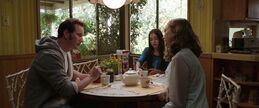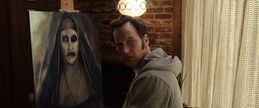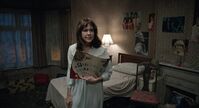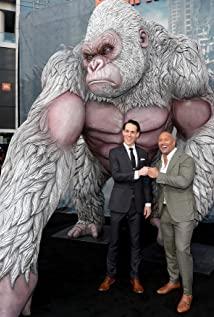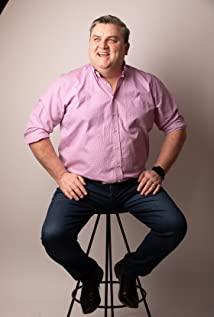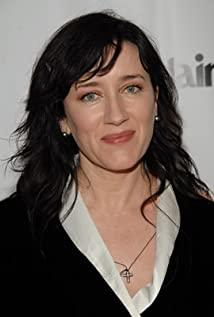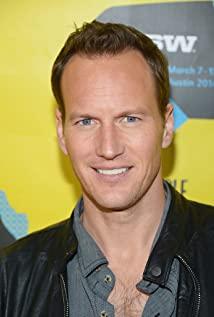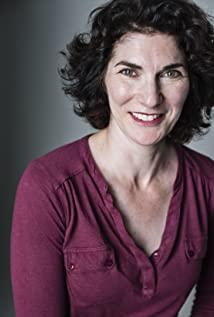.
He found a crooked sixpence against a crooked stile; with
crooked sixpence in hand, stepped up crooked steps,
He bought a crooked cat, which caught a crooked mouse, which caught a crooked mouse
.
And they all lived together in a little crooked house
.
-------- Mother Goose
Accompanied by a spinning revolving lantern, children sing a crooked man. This nursery rhyme also appears in a novel by Agatha Christie called "Crooked House." I simply wrote an introduction to attach it at the end. This spooky nursery rhyme, accompanied by the case of an old man who was poisoned by his family, hangs over the whole story. And this old man, I assume he is the old man in the film.
If you also assume that this nursery rhyme is an appropriate connection, please continue to think about it. If you think it is not, then stop here, because next I will write about the connection between the two.
In the novel "Deformed House", the crooked old man died, and the reason why he was crooked was because he always made his fortune by exploiting loopholes. Then one day he was poisoned by his family, and then the family thought the murderer was Brenda, the sequel to the old man, the young girl, they thought it must be the young Brenda who couldn't wait, and killed the old man for money Old man, no one thought that the real murderer was the cutest child in the family, Josephine. In The Conjuring 2, this crooked old man came to a single-parent family, a divorced woman and her four children. He came to find his family, but found that they were all gone. The little girl was possessed by him, and the whole family turned to everyone for help. This time, people once again made a firm judgment based on their previous experience, although this was manifested in a seemingly opposite but consistent phenomenon. Simply put, just as in "Freakhouse", people believe that the old grandfather's young wife is a criminal based on their own moral experience, and in the end they learn that the murderer is a child; in "The Conjuring 2", people based on scientific beliefs Superstition (or, in other words, obsession), identified as a child's prank, and further deduced that it was a farce written and directed by the whole family for the sake of attracting attention due to the poor life.
Then, people will be slapped with a sap again. \(^o^)/~
Does the devil exist?
In the eyes of those who think this family is trying to make big news, the devil is a little girl. Before the advent of Valak, the demon was the grandfather, a manifestation of obsession and control.
Do demons exist? If so, in what form?
Eco once said, "Perhaps the only real and only proof of the existence of the devil is the desire of everyone to know that the devil is at work." That devil, the background is different but not false. People are always eager to give the devil a name, an image, a reason, a logic, or whatever. The act of rushing to judge leads to a series of tragedies, whereby the devil exists and exists in the person itself - the mentality of rushing to take the blame, finding a basis and retreating to one's own safety zone, while the objective violence caused by rushing to judge can be achieved. Filled with life, sometimes it is shown with a kind of politeness that is irrelevant to oneself, but it is decidedly and coldly judged behind the scenes. Sometimes the judgment has been made, but it is manifested in a form that cannot be resolved.
There is a scene at the beginning of the film. The mother answers a teacher's phone call, then asks her daughter if she smokes cigarettes, and then she doesn't believe it. This is a foreshadowing. Behind this foreshadowing is the anxiety of lack of identity caused by trust, and communication is impossible. After that (without trying to remedy it), it is full of hidden dangers that bury doubts in life, and the subsequent development of the story extends this ruthlessness from family to society, or from family members to between family and society. This is the case in real life, objective violence is often left unresolved, and a general moral view makes people feel that "questioning it will make the situation worse", or "don't want to get involved", or "it is also an accusation to bring it up. ”, while secretly judging others in the mind. After the mother asked, the little girl denied it, but the knot in the child's heart was not untied until the play, "Do you believe me? I really don't smoke." "Do you believe me? I didn't kill the old man."
It is not difficult to find that no matter where, society operates mechanically, institutions need evidence, they need to prove that it is not a prank of the little girl and the whole family, and the devil gives institutions the evidence they want, and the people who are eager to retreat to the safe zone only It takes a proof to let go, "Look, they made it up!" "This is the reward you dare to believe!", Find a proof to ignore everything before, and make a "right" decision to leave without help. It is not the machinery of institutions but the machinery of thinking. This is exactly in line with the attitude of the family described in Christie's "Deformed House". Some of them pretend to have a tolerance that has nothing to do with themselves or express inconvenient grace to avoid the conflict brought about by positive dialogue, and some of them have already chosen a posture of indifference. Dealing with self-dissatisfaction is something that is far from being avoided. People avoid the self-doubt that dialogue brings by avoiding conversation, because it hurts the innermost reality and expectations. This avoidance is as cold as a dagger and poison, not a sword. The same is true in "The Conjuring 2". Everything seems to be overwhelmed by dealing with a farce. When it is recognized as a farce, it is already crooked, and it is harmless to continue a crooked road... Wallack is well aware of the mechanical human and the spread doubt eager conviction, eager to seize a desired appearance, experience or morality is a roll of tape - meet expectations - and also the Wa Lake trail of truth embedded therein.
If the tyranny of patriarchal ideology leads to deformities family house Waiting to be trained to be assigned and controlled, but silently dissatisfied with the outwardly submissive posture, then in The Conjuring 2 is controlled by mechanical consciousness, with bureaucratic and technical institutions as auxiliary social relations.
Just like a detective looking for the source of evil, the hero and heroine began the journey of exorcism.
In the process of exorcism, I have seen two kinds of efforts, one is the struggle of argument. The little girl said to her mother in the play, I really didn't smoke, I just wanted to pretend to be a little bad. Choosing to clarify can be to clarify misunderstandings for oneself, or it can be a hope to heal the harm caused by misunderstandings to the other party. It is a supplement, an attempt to break through suspicion and doubt, a courage to take on what may be more misunderstood, against avoidance and withdrawal. This kind of resistance does not exist in "Deformed House". The crooked grandfather controls little Josephine and prevents her from going to ballet. Others don't care about it. Grandpa marries a wife. . The indifference to others makes the house harmonious, they shun conflict, wear the mask of love for others, and exercise a kind of self-preservation extreme, or as Agatha said, cruel ruthlessness. In "The Conjuring 2", the little girl's unraveling of the knot is a turning point, or a breakthrough, that leads the plot to transparency.
Another effort, I think, is the effort of believing and trying to communicate. The truth is often not beautiful (yes, the truth is Marlene Manson, beautiful? Every time he appears, in your head in your head zombie zombie zombieeee~). Here is the effort of the hero and heroine. It is not difficult to find that the cosplay Sister with Marlene Manson's makeup is the heroine herself, implying that the heroine herself is both a monk and a demon. As something that is willing to foresee the truth for powerful people, Valak is the externalization of the heroine's inner fear. The line is laid out in the film in a subtle way. And assume the role of revealing everything, that is, exorcism skills. One thing to emphasize is that it was the heroine who asked who the transvestite demon ta was, and then Valak rudely told her her real name, (this is an effort, people will probably run away when they see a ghost, Think about those two kind and cute little policemen~ Yes, if you don't judge, the devil really can't do anything about you, and the problem is there.
The heroine has already looked into the abyss, and the abyss also looks back at you. What follows is a test of the heroine's faith, a foresight that takes the hero as the price. Fear comes from skepticism of the unknown and faith in foresight. The male protagonist who has no foresight seems to rush in without thinking too much (the fearless is ignorant but loving)! All of this is in Varak's plan, and Ta even cut the branches. As I just mentioned, objective violence caused by eager judgment is full of life, and the problem of not judging is still there. Sad things happen and people sometimes have to make judgments. Kind-hearted demons also go to great lengths to find capable people. In fact, I think Ta must be an angel too, and she is also an angel who likes to make skewers. If you don't judge, just use your husband to make skewers (⊙v⊙). Because the heroine has been masochistically following the trail of Valak, she got Valak's real name. Yes, the truth is such chicken soup, "Sometimes people need a little pressure, don't they?" (Take your husband for a skewer~ The devil is the devil's way of killing people is very direct, much more merciful than man crucifying the Son of Man). Something scary becomes something in your constant masochistic pursuit.
In fact, Valak has always appeared in human society in a subtle image. It is a little baby with angel wings riding on a two-headed dragon, curious and willing to share the truth with some people.
The following is a simple storyline of the
Crooked House : the protagonist falls in love with Sophia, and Sophia's grandfather is poisoned. Since the protagonist's father is a police officer, I participate in the investigation. Soo's family lives in a crooked house, and Soo's grandfather After the war, he went from Greece to England to make a fortune (walked a crooked mile), married a young wife (a crooked cat) in his later years, and his wife and tutor (a crooked mouse, described in the original text as poor as a church mouse) flirted with each other. Then one day my grandfather died because his insulin was replaced with something else.
Postscript, I want to say that this film is very humorous, very comedy, and indeed very scary. . . That's enough, it shows the mysterious subconsciousness of human beings. It's good to be terrifying, and the rest of the truth is the part that floats on the water. . .
View more about The Conjuring 2 reviews



